

The Gallipoli campaign. Each year on Anzac Day, New Zealanders (and Australians) mark the anniversary of the Gallipoli landings of 25 April 1915.
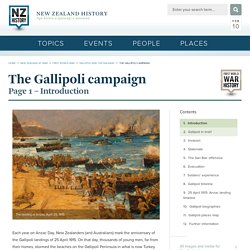
On that day, thousands of young men, far from their homes, stormed the beaches on the Gallipoli Peninsula in what is now Turkey. For eight long months, New Zealand troops, alongside those from Australia, Great Britain and Ireland, France, India, and Newfoundland battled harsh conditions and Ottoman forces desperately fighting to protect their homeland. By the time the campaign ended, more than 130,000 men had died: at least 87,000 Ottoman soldiers and 44,000 Allied soldiers, including more than 8700 Australians.
Among the dead were 2779 New Zealanders, about a fifth of all those who had landed on the peninsula. In the wider story of the First World War, the Gallipoli campaign made no large mark. Anzac Day - Anzac Day. Anzac Day occurs on 25 April.

It commemorates all New Zealanders killed in war and also honours returned servicemen and women. The date itself marks the anniversary of the landing of New Zealand and Australian soldiers – the Anzacs – on the Gallipoli Peninsula in 1915. The aim was to capture the Dardanelles, the gateway to the Bosphorus and the Black Sea. At the end of the campaign, Gallipoli was still held by its Turkish defenders. Thousands lost their lives in the Gallipoli campaign: 87,000 Turks, 44,000 men from France and the British Empire, including 8500 Australians. Premier's Anzac Prize 2015 presentation winning entry. Great War remembered in Orewa. The 100th anniversary of the start of World War I was commemorated by Orewa College on Tuesday with a battle scene, a replica trench, a fly past and a visit from the New Zealand Defence Force.

The re-enactment of a battle scene was performed by Year 13 students, who are in rehearsals for the school’s production of New Zealand play Once on Chunuk Bair. They were joined by the Chief of Defence Force, Lieutenant General Timothy Keating, who arrived by Air Force helicopter and inspected the trench dug into the side of the school field. “I heard about the school creating the trench and I had to come see what they had done. It’s outstanding they went to that level. “Talking to the students in the trenches, it obviously had a real impact on them too.” WW1 Their Stories - Our History - Home. Children of Gallipoli documentary.
The Gallipoli Catastrophe Documentary. Memories of an ANZAC soldier in Gallipoli war 1. 100 Years Since The Launch Of The Naval Attack In The Battle Of Gallipoli. Armistice Day 2011: The mother who lost five sons in WW1. By Annabel Venning for MailOnline Updated: 10:25 GMT, 11 November 2011 The moment Amy Beechey saw the envelope with a French postmark she feared the worst.

Sent from a military hospital in Rouen, dated December 29, 1917, it brought the news she had been dreading. Her son, 36-year-old Rifleman Leonard Beechey, wounded and gassed at the battle of Cambrai a month earlier, had died of his wounds. Tetanus set in and the doctors could do nothing to save him. He would, the chaplain told his mother, be buried in Rouen, far from the Lincolnshire countryside where he and his seven brothers had grown up, together with five sisters (a sixth sister had died aged five).
Viewpoint: 10 big myths about World War One debunked. 25 February 2014Last updated at 15:45 GMT Much of what we think we know about the 1914-18 conflict is wrong, writes historian Dan Snow.
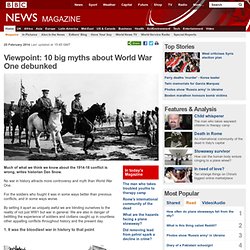
No war in history attracts more controversy and myth than World War One. The Anzac landing at Gallipoli. Copyright information Information relating to the 11th Battalion is supplied by the AIF Project, School of History, University College, UNSW, Australian Defence Force Academy, Canberra. © The University of New South Wales 2000.
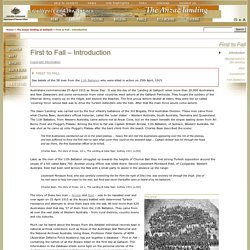
Not to be reproduced, stored in a retrieval system, or transmitted in any form without the prior written consent of the copyright holder. Australians commemorate 25 April 1915 as 'Anzac Day'. New Zealand Soldiers At War: Voices From The Past. New Zealand Soldiers’ War Stories Discover the real war stories of our Kiwi soldiers as they served New Zealand around the world, including World War I and II.
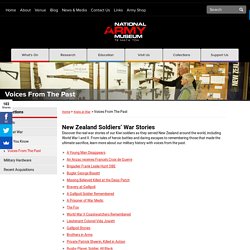
From tales of heroic battles and daring escapes to remembering those that made the ultimate sacrifice, learn more about our military history with voices from the past. A Young Man Disappears A series of World War One embroidered postcards held within the Museum’s archives were sent by Private Rupert Sydney Taucher to loved ones at home in New Zealand during his time in England and the Western Front.
The postcards reveal the close relationship he shared with his family despite the long distance that separated them. Researching New Zealand soldiers in the First World War. 100,000 New Zealand men signed up to fight for King and Country in the First World War.

Their names were listed in the Nominal rolls of New Zealand Expeditionary force, published by the government between 1917 and 1919. These rolls are available through public libraries in their original printed form and on microfiche. The New Zealand Society of Genealogists has indexed this information into their New Zealand World War I service personnel & reserves index CD-Rom, which is available in many public libraries and to purchase directly from the Society: Marlborough Express — 28 December 1915 — Page 3. WW1 Battlefields of the Western Front. The long line of battlefields that makes up the Western Front runs through a wide variety of landscapes in south-west Belgium, north-eastern and eastern France.
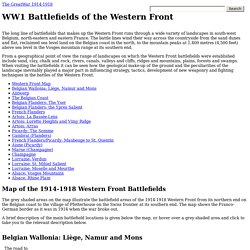
The battle lines wind their way across the countryside from the sand dunes and flat, reclaimed sea level land on the Belgian coast in the north, to the mountain peaks at 1,400 metres (4,500 feet) above sea level in the Vosges mountain range at its southern end. From a geographical point of view the range of landscapes on which the Western Front battlefields were established include sand, clay, chalk and rock, rivers, canals, valleys and cliffs, ridges and mountains, plains, forests and swamps. When visiting the battlefields it can be seen how the geological make-up of the ground and the peculiarities of the landscape inevitably played a major part in influencing strategy, tactics, development of new weaponry and fighting techniques in the battles of the Western Front. Map of the 1914-1918 Western Front Battlefields Antwerp. Significance of Anzac Day - Anzac Day Guide. On 25 April 1915, eight months into the First World War, Allied soldiers landed on the shores of the Gallipoli peninsula.

This was Turkish territory that formed part of Germany's ally, the Ottoman Empire. The troops were there as part of a plan to open the Dardanelles Strait to the Allied fleets, allowing them to threaten the Ottoman capital Constantinople (now Istanbul) and, it was hoped, force a Turkish surrender. The Allied forces encountered unexpectedly strong resistance from the Turks, and both sides suffered enormous loss of life. Soldier & letter from home. First World War. Origins The First World War was caused by the destabilisation of the balance of power in Europe due to the rise of Germany.
The war began in 1914 when Austria-Hungary invaded Serbia because of the assassination of an archduke. WORLD WAR ONE TRENCH WARFARE. In the trenches of 1914-1918. What were the trenches? Although most of us think primarily of the Great War in terms of life and death in the trenches, only a relatively small proportion of the army actually served there. The trenches were the front lines, the most dangerous places. But behind them was a mass of supply lines, training establishments, stores, workshops, headquarters and all the other elements of the 1914-1918 system of war, in which the majority of troops were employed. The trenches were the domain of the infantry, with the supporting arms of the mortars and machine-guns, the engineers and the forward positions of the artillery observers. The Anzac landing at Gallipoli. The Anzac landing: overview Why did theAnzacs land?
25 April 1915: Anzac Cove, Gallipoli Historians still debate whether the Anzac troops were landed at the correct place. BBC iWonder - How did so many soldiers survive the trenches? How many New Zealanders served on Gallipoli? As the centenary of the First World War approaches, people are interested in how many Kiwis served in the various campaigns. For Gallipoli, the answer is not straightforward – and the waters have been muddied by a mistake by a senior British general that went unnoticed for nearly a century. Sir Ian Hamilton was a respected military thinker but not a great success as head of the Mediterranean Expeditionary Force (MEF), the cobbled-together Allied army which began landing on Turkey’s Gallipoli Peninsula on 25 April 1915. I’ve recently realised that Hamilton was also responsible for a significant underestimate of the number of men who served on Gallipoli in New Zealand units of the MEF. Sir Ian Standish Monteith Hamilton.
Library of Congress, LC-DIG-ggbain-18025. Battle of Gallipoli - World War I. With World War I stalled on the Western Front by 1915, the Allied Powers were debating going on the offensive in another region of the conflict, rather than continuing with attacks in Belgium and France. Early that year, Russia’s Grand Duke Nicholas appealed to Britain for aid in confronting a Turkish invasion in the Caucasus. (The Ottoman Empire had entered World War I on the side of the Central Powers, Germany and Austria-Hungary, by November 1914.) In response, the Allies decided to launch a naval expedition to seize the Dardanelles Straits, a narrow passage connecting the Aegean Sea to the Sea of Marmara in northwestern Turkey.
If successful, capture of the straits would allow the Allies to link up with the Russians in the Black Sea, where they could work together to knock Turkey out of the war. Anzac. New Zealand at War Timeline. Anzac Day Collection - Collection. History - World Wars: Battle for Gallipoli: February 1915 - January 1916.